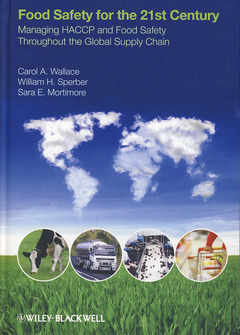Food safety for the 21st century Managing HACCP & food safety throughout the global supply chain
Auteurs : WALLACE, MORTIMORE Sarah

The HACCP (Hazard Analysis and Critical Control Points) system is still recognised internationally as the most effective way to produce safe food throughout the supply chain, but a HACCP system cannot operate in a vacuum. It requires prerequisite programmes to be in place and it can be highly affected by, or dependent upon, other major considerations such as animal, plant, human and environmental health, food security and food defence. This book Provides a practical and up-to-date text covering the essentials of food safety management in the global supply chain, giving the reader the knowledge and skills that they need to design, implement and maintain a world-class food safety programme. Builds on existing texts on HACCP and food safety, taking the next step forward in the evolution of HACCP and providing a text that is relevant to all sectors and sizes of food businesses throughout the world. Shares practical food safety experience, allowing development of best-practice approaches. This will allow existing businesses to improve their systems and enable businesses that are new to HACCP and food safety management requirements in both developed and developing countries to build on existing knowledge for more rapid application of world-class food safety systems. Educates practitioners such that they will be able to use their judgement in decision-making and to influence those who make food policy and manage food operations. This book is an essential resource for all scientists and managers in the food industry (manufacturing and foodservice); regulators and educators in the field of food safety; and students of food science and technology.
Acknowledgements.
Disclaimer.
How to use this book.
The authors.
Glossary of terms and acronyms.
PART ONE: FOOD SAFETY CHALLENGES IN THE 21ST CENTURY.
1 Origin and evolution of the modern system of food safety management: HACCP and prerequisite programmes.
1.1 Historical perspectives.
1.2 Origin and evolution of HACCP.
1.3 The necessity of prerequisite programmes.
1.4 The future of HACCP.
2 Lessons learned from food safety successes and failures.
2.1 Introduction.
2.2 Benefits of using HACCP - lessons learned from successful implementation.
2.3 Misconceptions or 'failure to understand HACCP'.
2.4 Barriers to effective HACCP use.
2.5 Reasons for failure.
2.6 Difficulties with applying HACCP through the entire food supply chain.
2.7 Roles and responsibilities - lessons learned.
2.8 Conclusions.
3 Food safety challenges in the global supply chain.
3.1 Introduction.
3.2 Increased complexity of the global supply chain.
3.3 Food safety issues in global trade.
3.4 Strategic-level responses.
3.5 Tactical level responses.
3.6 Conclusions.
4 The future of food safety and HACCP in a changing world.
4.1 Introduction.
4.2 Food safety issues.
4.3 Technology advancements.
4.4 Food safety management.
4.5 Changes in thinking/policy making.
4.6 Conclusions.
PART TWO: FOODBORNE HAZARDS AND THEIR CONTROL.
5 Recognising food safety hazards.
5.1 Introduction.
5.2 Biological hazards.
5.3 Chemical hazards.
5.4 Physical hazards.
5.5 Conclusions.
6 Designing safety into a food product.
6.1 Introduction.
6.2 Formulation intrinsic control factors.
6.3 Use of experimental design and analysis.
6.4 Ingredient considerations.
6.5 Conclusions.
7 Designing a safe food process.
7.1 Introduction.
7.2 Process control of microbiological hazards.
7.3 Process control of chemical hazards.
7.4 Process control of physical hazards.
7.5 Conclusion.
PART THREE: SYSTEMATIC FOOD SAFETY MANAGEMENT.
8 Overview of a world-class food safety programme.
8.1 Introduction.
8.2 Preliminary concepts and definitions.
8.3 World-class food safety programmes in the global food supply chain.
8.4 Continuous improvement of the world-class food safety programme.
8.5 Conclusions.
9 Building the foundations of a world-class food safety management programme: essential steps and practices.
9.1 Introduction.
9.2 Essential management practices.
9.3 Preparation activities for food safety programmes.
9.4 Prioritisation of corrective actions.
9.5 Conclusions.
10 Formalised prerequisite programmes in practice.
10.1 Introduction.
10.2 Prerequisite definitions and standards.
10.3 Prerequisite programmes - the essentials.
10.4 Prerequisite programmes and operational prerequisites.
10.5 Validation and verification of prerequisite programmes.
10.6 Conclusions.
11 Conducting a product safety assessment.
11.1 Introduction.
11.2...
Date de parution : 11-2010
Ouvrage de 320 p.
Disponible chez l'éditeur (délai d'approvisionnement : 12 jours).
Prix indicatif 165,11 €
Ajouter au panier


